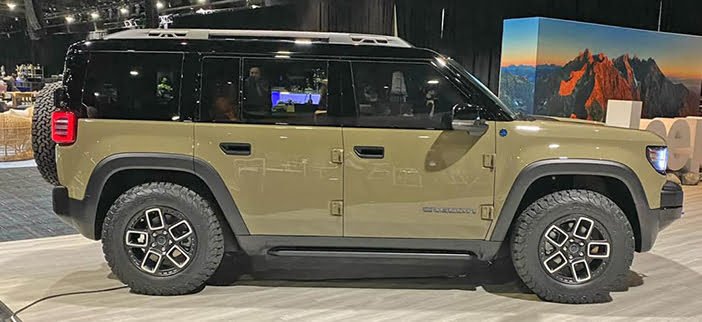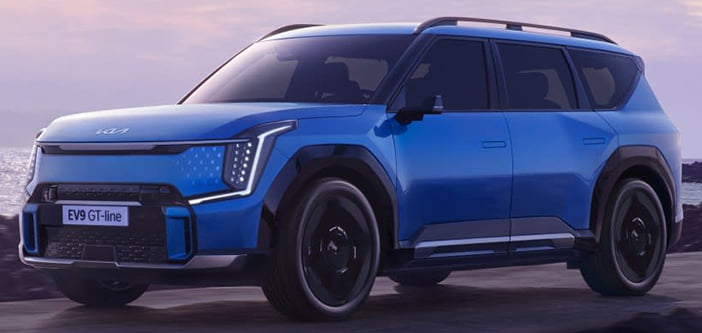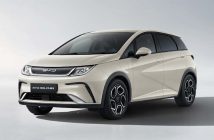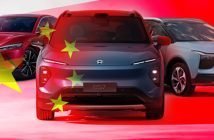+++ ASTON MARTIN is expected to launch the recast DB11 late this year, redesigned inside and re-engineered under the skin to be what CEO Lawrence Stroll says it “should have always felt like”. The automaker boss also having said the transformation will be enough to consider the coupe a new car, it’s no surprise to hear CarBuzz found a trademark application for the name DB12. An automaker spokesperson told: “Aston Martin regularly files international trademark applications to protect names for possible future use”. If the DB12 name ends up as retail fact, 2023 will welcome the first even-numbered DB-series production car since the end of the DB6 in 1971. The DB11 has been on the market for 6 years, debuting to a burst of appreciation for replacing the 14-year-old DB9 with new design language and the afterglow of the one-off DB10 from ‘Spectre’. Since then, despite Aston’s solid order books, the middle-child DB11 perhaps wanted for attention through the turmoil in the executive suites and model reorganization. Stroll’s assessment of the coming coupe having “no similarity to the current cars” applies least of all to the exterior. Prototypes spied in Sweden and at the Nürburgring show standard modifications, tweaks to the grille and lower intake in front, redrawn side strakes, and what’s likely to be a new treatment for the taillights. The biggest and most obvious change might be the hood, the current clamshell supplanted by a traditional panel enclosed by nosecone and fenders. We anticipate both the Mercedes-sourced 4.0-liter V8 with 510 hp and the brand’s 5.2-liter V12 making 630 hp to stay in circulation, both benefiting from the obligatory power bump. With electrified Aston Martins due around the same timeframe as the launch of the DB12, it’s possible the V8 version of the coupe comes to market with a 48-volt hybrid system. The jewel of the interior remodel might be the new infotainment system. Still built on Mercedes technology, a reskin will mean English superluxury polish complete with “a proper English accent” and possibly upgraded tech such as wireless Android Auto and Apple CarPlay. +++
+++ In January, German outlets reported Mercedes-Benz will give up the recently inaugurated EQS naming scheme for battery-electric cars. The automaker doesn’t plan to release new ICE vehicles after 2025, making the differentiation unnecessary in a few years. Earlier this month, Audi CEO Markus Duesmann explained that Audi would revamp its vehicle naming scheme to give ICE vehicles odd numbers, EVs getting even numbers. The last of the German Big Luxury Three might be about to throw its marker onto the naming table: BMW filed more than 40 applications to trademark names for vehicles from the i118 to the iX760 and an M350. The 48 trademark applications combine 4 letter- or number-defined categories, names starting with either “i”, “X”, “iX”, or “M”, followed by a number. It’s possible the “i” represents electric cars as in the i7, “X” represents SUVs, “iX” therefore represents an electric SUV and “M” stands for you-know-who. The number would define a car’s place in the output hierarchy. Of course, the full list leaves us with 2 large unknowns. The first is whether these trademarked alphanumerics would form entire model names or merely the roots of model names. The present BMW lexicon includes suffixes like “d”, “i”, “e”, “sDrive”, “xDrive” and “MPerformance”. There’s no reason the potentially tidy iX560 wouldn’t turn into iX560 xDrive come production time. The second is whether the non-electrics would bear the same trim steps. The production X5 range in the States comprises the X5 s- and xDrive40i, X5 xDrive50e, X5 M60i, and X5 M Competition. Those first three might be tied to the trademark list as the future X540, X550, and X560. But then would the iX540, iX550, and iX560 simply be the electric versions of the trio? We probably won’t have to wait too long to find out. With the bread-and-butter 5 Series entering a new generation soon, it’s possible a new scheme comes with it. Also, let’s remember that nothing might come of this: automakers constantly file trademark applications all over the world. However, maybe something should come of this. BMW names have gotten, like some German words, uncomfortably long and packed with detailed information you can understand only if you know the language. +++
+++ BYD ’s profit more than quintupled last year after the Chinese automaker sold a record number of electric vehicles and intensified its battle with Tesla for market share. Net income soared 446% to 16.6 billion yuan ($2.4 billion), the company said Tuesday, in line with the 16 billion to 17 billion yuan preliminary profit it reported on January 30. Analysts expected 15.98 billion yuan. BYD sold 1.86 million electric and plug-in hybrids in 2022, more than the previous four years combined and accounting for about 30% of all new-energy vehicle sales in China. Half of them were battery-only EVs. In comparison, Tesla delivered 1.31 million EVs. BYD stopped producing cars powered entirely by fossil fuels last year. New luxury EV launches will help BYD broaden its offerings this year and should help fuel further earnings growth. But margins are likely to be squeezed by an ongoing price war in China that was sparked by Tesla with cuts on its locally-made models. Warren Buffett-backed BYD is stepping up its push overseas, including into Norway, Denmark, the Netherlands, Thailand and Australia. BYD shares rose 1.5% in Hong Kong trading before the results Tuesday. They are down almost 20% since the start of February, when the price war intensified and data showed Chinese car sales plunged in January as purchases slowed during the Lunar New Year holiday. Company founder Wang Chuanfu will host an post-earnings event with analysts and media in Hong Kong on Wednesday morning. +++
+++ Companies such as FORD are collectively pouring hundreds of billions of dollars into electric vehicles (EVs). But as the industry transitions toward zero carbon emissions, battery supply chains could stand in the way of those ambitions. “First of all, batteries are the constraint here”, Ford CEO Jim Farley told. “Both lithium and nickel are really the key constraining commodities. We normally get those from all over the world: South America, Africa, Indonesia. We want to localize that in North America, not just the mining but the processing of the materials”. Farley pointed out that even raw metals mined in the U.S. often get sent back to China to be processed, something the U.S. is actively trying to counter through grants and additional investments. “The big change is going to be onshore all that capability of processing but also mining back in the U.S.” Farley added. “It will be a huge job, just like it has for semiconductors”. In 2021, electric vehicles made up about 10% of all vehicle sales globally, according to the International Energy Agency (IEA). By 2030, half of all U.S. car sales will be EVs, spurred on by Inflation Reduction Act tax credits. As demand for electric cars and trucks increases (and there would have to be an estimated 300 million electric cars on the road in 2030 in order to stay on track with benchmark net-zero goals) so too will demand for the precious minerals used in batteries. That, in turn, could test the global supply chains that extract and process minerals. The U.S. has outlined five minerals it deems “critical” to the EV transition that have supply chains at risk: lithium, cobalt, manganese, nickel and graphite. Already, lawmakers and those in the mining industry have raised alarms about mineral supply. “There’s going to be a real crunch to get the material”, Keith Phillips, CEO of Piedmont Lithium, told in September about lithium mining. Lithium is a key component in lithium-ion batteries, the most dominant type of battery used in the EV industry and the kind that Ford uses. The average electric car battery uses about 8 kg to 10 kg of the metal. “We don’t have enough in the world to turn that much production in the world by 2035”, Phillips said. Notably, lithium-ion battery demand is expected to explode by more than 500% between 2020 and 2030. Although the U.S. has developed some capacity for battery production, China dominates the market with more than 70% of global EV battery production capacity within its borders. China is the largest producer of graphite, one key mineral used in lithium-ion batteries, but its strength comes mainly from its refining capacity. Once a raw material is extracted from the earth, it is sent to processors to purify the mineral, which is then sent to producers who manufacture the batteries that go into consumers’ cars. Overall, raw minerals can travel as many as 80.000 km before reaching a battery factory. But as geopolitics, weather extremes and spiking commodity prices threaten those supply chains, many automakers are making a concerted effort to shore up their own networks. Ford announced in February another $3.5 billion investment in a new battery plant in Marshall, Michigan, as a part of its $50 billion global push toward electrification. The automaker acknowledged a $2.1 billion loss in its Model E electric division in 2022 and said it expects a $3 billion loss for the unit in 2023 as the company undergoes a restructuring and makes key investments in EVs. “We have to get these materials from around the world until we localize the supply chain, which is what we want to do”, Farley said. “By the end of the year, we’ll secure all the raw materials to make the 2 million batteries by 2026 that we are going to need to go into our vehicles. We should be in good shape here”. +++
+++ With dealers returning to regular life after Stellantis’ Dealer Business Meeting 2023 in Las Vegas last week, bits of intel are escaping. JEEP is making moves on several fronts. There was an electrified concept brought to the meeting, the Recon Moab 4xe (pictured). It looks like an upsized Renegade, its tire size thought to be 285/70R17, same as the stock Wrangler Rubicon. The end of the Cherokee is but a hiatus, Appearance-wise, a new version in the works is said to be a smaller version of the Grand Cherokee L that’s about the same size as the outgoing model. When it launches in late 2024 , it could debut with a new name as well as hybrid and electric powertrains. The Grand Cherokee, meanwhile, will get a mid-cycle refresh in 2025. +++

+++ KIA just revealed the EV9 and all its glorious details, but it’s not entirely done. In a press conference with media, CEO Ho-Sung Song revealed that a high-performance EV9 GT model will eventually join the lineup. “We are aware of growing demand for high-performance vehicles in electric applications”, Song said. “And building on our success of our Kia EV6 GT, we are happy to announce that we are currently developing a high performance version of EV9”. At market launch, the EV9’s highest performance version will be a dual-motor AWD version with 380 hp and 600 Nm of torque. You’ll also be able to upgrade that model via an after-purchase “Boost” upgrade to have up to 700 Nm of torque. Kia says with the upgrade, the EV9 is capable of running a 5.3-seconds 0-100 kph time. Of course, an EV9 GT would need to be even quicker than that. Currently, the only reference to go on is the EV6 GT, which packs 576 horsepower and 730 Nm of torque. It’ll do the 0-100 kph sprint in only 3.4 seconds. Considering the EV9 GT will be significantly heavier than the EV6, it only makes sense to pack even more power into the EV9. Of course, expect matching suspension, brake and styling upgrades to go with the extra power, too. “It aims to redefine what performance means in an electric SUV”, Song continued. “We plan to release the GT version of EV9 in early 2025”. With that timeframe, the EV9 GT will be launching about a year and a half after the regular version does. Kia says the standard EV9 will be headed to our side of the world later this year, and you can read all about it in our in-depth reveal story here. +++

+++ Electric-vehicle maker LUCID GROUP is planning to lay off about 18% of its workforce, media reported on Tuesday, citing sources familiar with the matter and an internal memo. The company’s shares fell more than 7%. Lucid, which makes luxury electric cars, will communicate details of the layoffs in the next 3 days, according to the report. At the end of last year, the company had about 7.200 employees. If that’s the current level, then the layoff would amount to a reduction of about 1.300 workers. +++
+++ As the exodus of Western carmakers narrows options for consumers in RUSSIA , Chinese automakers are filling the gap, forcing Russians to overcome their reluctance to embrace Chinese brands and stomach higher prices. Chinese brands such as Haval, Chery and Geely now account for almost 40% of Russia’s new car sales, data from analytical agency Autostat and consulting company PPK showed, up from less than 10% in January-February of 2022, pouncing on the opportunity left by the exit of firms such as Renault, Nissan and Mercedes. But there are teething problems. Reuters spoke to several Russian car buyers (individuals and dealerships) who perceived the quality of some Chinese cars to be lower than Western rivals and industry experts said Chinese manufacturers needed to enhance their reputation even as their market share soars. Stepan, 28, who has increasingly driven Chinese cars when using carsharing services, is among those that need convincing. Among his complaints was the smoothness of the drive. “I managed to buy a Skoda in 2022. If you want my honest opinion, the difference with Chinese cars is massive”, he told Reuters at Moscow’s Favorit Motors dealership. Czech carmaker Skoda Auto, part of Volkswagen Group and one of several Western automakers that had local car production, is in the final stages of a deal to sell its Russian assets in the wake of Western sanctions after Moscow despatched troops to Ukraine last February. When buying his new Chinese car, Alexander, 74, looked for one which encompassed Swedish technology. “I believe that in time the reliability will improve”, he said. “For example, I know that Geely Tugella has a Volvo engine. This sold this car for me”. Russia’s former president Dmitry Medvedev said on Friday after a visit to China in December that cooperation with Chinese manufacturers was good and consumers’ perceptions were out of date. “We used to laugh at some of their designs, but I went for a ride in a local car and looked at others”, he said. “I’ll say bluntly: the car I drove was certainly no worse than a Mercedes”. Most Western automakers, who have fought with domestic carmakers for market share since they began building factories in Russia in the early 2000s, ceased operations last spring. “We’ve lived our whole lives focused on European, Japanese, American brands and did not especially take the Chinese market into account, which has developed at an incredible rate”, said Vladimir Shestak, general director of Altair-Auto in Vladivostok, whose dealership specialises in the Mercedes-Benz and Geely brands. Though the majority of foreign firms have exited Russia or are in the process of leaving, lingering stocks and parallel imports mean some companies’ cars remain on sale for now. Domestic producer Avtovaz’s Lada brand is Russia’s most popular. Renault, through its former controlling stake in Avtovaz, had the highest market share among foreign producers before Russia began what it calls its “special military operation” in Ukraine. While Chinese cars are increasingly filling the gap, the lack of reputation remains an issue, said auto industry expert Sergey Aslanyan. “Yes, they have almost no competitors here anymore”, he said. “But that does not mean that people will change their opinion quickly”. Chinese brands’ market share reached 37.15% in January-February, up from 9.48% a year earlier, Autostat and PPK data showed. Sales of departing European, Japanese and Korean brands were down to 22.6% from 70%. The sharp swing comes, however, amid plummeting sales of new cars, which slumped 58.8% in 2022 as lower living standards and a desire for Western-made vehicles caused people to reduce their spending and purchase more used cars. In a sign of growing cooperation China’s Haval is now producing cars locally, while in Moscow, the revived Soviet-era Moskvich is using engine parts, design and engineering from China’s JAC. But another gripe for consumers is the price. Even Medvedev said the Moskvich’s price looked a little high. The model 3 costs around 2 million roubles ($26,195). Prices for the Lada Granta, Russia’s most widely sold car, start at around 680.000 roubles. “The Chinese are bringing in a lot of cars but if we talk about price, not quality, there are no cheap cars at all”, said Maxim Kadakov, editor in chief of the “Behind the Wheel” magazine. +++



